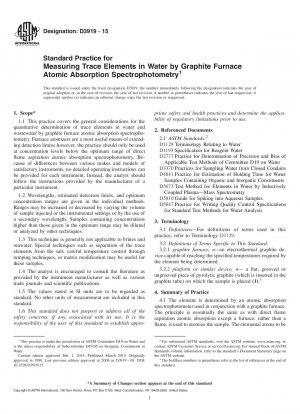ASTM D3919-15
Standard Practice for Measuring Trace Elements in Water by Graphite Furnace Atomic Absorption Spectrophotometry
- Standard No.
- ASTM D3919-15
- Release Date
- 2015
- Published By
- American Society for Testing and Materials (ASTM)
- Latest
- ASTM D3919-15
- Scope
5.1 Elemental constituents in potable water, receiving water, and wastewater need to be identified for support of effective pollution control programs. Currently, one of the most sensitive and practical means for measuring low concentrations of trace elements is by graphite furnace atomic absorption spectrophotometry. ICP-MS may also be appropriate but at a higher instrument cost. See Test Method D5673.
1.1 This practice covers the general considerations for the quantitative determination of trace elements in water and wastewater by graphite furnace atomic absorption spectrophotometry. Furnace atomizers are a most useful means of extending detection limits; however, the practice should only be used at concentration levels below the optimum range of direct flame aspiration atomic absorption spectrophotometry. Because of differences between various makes and models of satisfactory instruments, no detailed operating instructions can be provided for each instrument. Instead, the analyst should follow the instructions provided by the manufacturer of a particular instrument.
1.2 Wavelengths, estimated detection limits, and optimum concentration ranges are given in the individual methods. Ranges may be increased or decreased by varying the volume of sample injected or the instrumental settings or by the use of a secondary wavelength. Samples containing concentrations higher than those given in the optimum range may be diluted or analyzed by other techniques.
1.3 This technique is generally not applicable to brines and seawater. Special techniques such as separation of the trace elements from the salt, careful temperature control through ramping techniques, or matrix modification may be useful for these samples.
1.4 The analyst is encouraged to consult the literature as provided by the instrument manufacturer as well as various trade journals and scientific publications.
1.5 The values stated in SI units are to be regarded as standard. No other units of measurement are included in this standard.
1.6 This standard does not purport to address all of the safety concerns, if any, associated with its use. It is the responsibility of the user of this standard to establish appropriate safety and health practices and determine the applicability of regulatory limitations prior to use.
ASTM D3919-15 Referenced Document
- ASTM D1129 Standard Terminology Relating to Water
- ASTM D1193 Standard Specification for Reagent Water
- ASTM D2777 Standard Practice for Determination of Precision and Bias of Applicable Methods of Committee D-19 on Water
- ASTM D3370 Standard Practices for Sampling Water from Closed Conduits
- ASTM D4841 Standard Practice for Estimation of Holding Time for Water Samples Containing Organic and Inorganic Constituents
- ASTM D5673 Standard Test Method for Elements in Water by Inductively Coupled Plasma8212;Mass Spectrometry
- ASTM D5810 Standard Guide for Spiking into Aqueous Samples
- ASTM D5847 Standard Practice for Writing Quality Control Specifications for Standard Test Methods for Water Analysis
ASTM D3919-15 history
- 2015 ASTM D3919-15 Standard Practice for Measuring Trace Elements in Water by Graphite Furnace Atomic Absorption Spectrophotometry
- 2008 ASTM D3919-08 Standard Practice for Measuring Trace Elements in Water by Graphite Furnace Atomic Absorption Spectrophotometry
- 2004 ASTM D3919-04 Standard Practice for Measuring Trace Elements in Water by Graphite Furnace Atomic Absorption Spectrophotometry
- 1999 ASTM D3919-99 Standard Practice for Measuring Trace Elements in Water by Graphite Furnace Atomic Absorption Spectrophotometry
